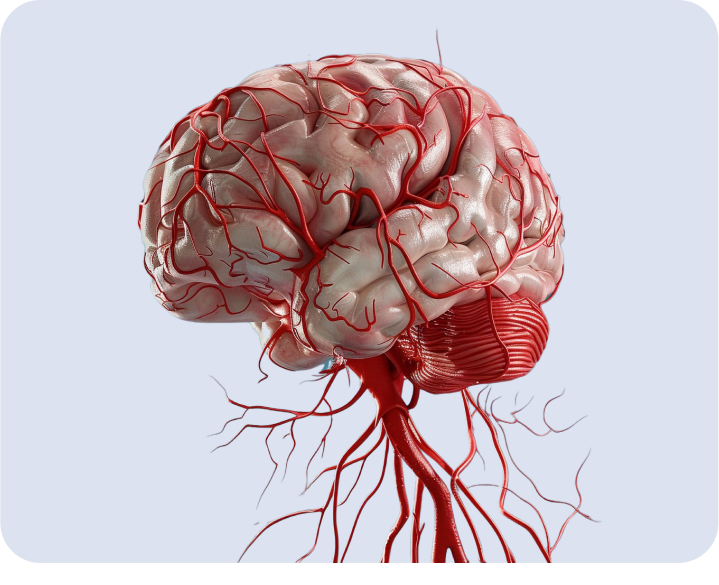Neurology - Page 5
Registered on ClinicalTrials
Treatment of dizziness in elderly patients with chronic cerebrovascular pathology
Author:
S.N. THOUGHT
Research Institute of Therapy and Preventive Medicine-a branch of the Federal State University "Federal Research Center Institute of Cytology and Genetics of the Siberian Branch of the Russian Academy of Sciences", Novosibirsk, Russia
The results of a randomized double blind multicenter placebo-controlled in parallel groups of the study and safety of Mexidol with prolonged consistent therapy in patients in acute and early restorations. Periods
Authors:
L.V. Stakhovskaya 1 , N.A. Shamalov 1 , DR Khasanova 2 , E.V. Melnikova 3 , A.S. Agafin 4 , K.V. Golikov 5 , E.I. Bogdanov 6 , A.A. Yakupova 6 , L.V. Roshkovskaya 7 , L.V. Lukin 8 , T.M. Lokstanova 9 , I.E. Patrunenova 10 , L.A. Shchepankevich 1 1
1 Research Institute of Cerebrovascular Pathology and Stroke of the Federal State Budgetary Institution “Russian National Research Medical University named after N.I. Pirogov »Ministry of Health of Russia, Moscow, Russia;
2 GAUZ "Interregional Clinical and Diagnostic Center", Kazan, Russia;
3 St. Petersburg GBUZ "City Hospital No. 26", St. Petersburg, Russia;
4 St. Petersburg GBUZ "City Hospital No. 40 of the Resort Administrative District", St. Petersburg, Russia;
5 St. Petersburg GBUZ "City multidisciplinary hospital No. 2", St. Petersburg, Russia;
6 FSBEI in Kazan State Medical University of the Ministry of Health of Russia, Kazan, Russia;
7 St. Petersburg GBUZ "Nikolaev Hospital", St. Petersburg, Russia;
8 GBUZ "Vsevolozhsk Clinical Interdistrict Hospital", Leningrad Region, Russia;
9 Mubz "City Clinical Hospital No. 1 named after N.I. Pirogov ", Samara, Russia;
10 GBUZ "Samara Regional Clinical Hospital named after V.D. Seredavina ”, Samara, Russia;
11 FGBNU "Scientific Institute of Experimental and Clinical Medicine", Novosibirsk, Russia.
Modern protection strategies for hypoxic-itchemic brain damage
Authors:
Yanishevsky S.N.*, Tsygan N.V., Golokhvastov S.Yu. , Andreev R.V., Litvinenko I.V. , Karpova O.S., Yakovleva V.A.
*FSBVOU in "Military Medical Academy named after CM. Kirov ”, St. Petersburg, Russia
Place of publication:
Journal of Neurology and Psychiatry, 12, 2017
Features of the manifestation of anxiety in patients of older age groups with different types of moderate cognitive disorder
Author:
Sidenkova A.P.
FSBEI in "Ural State Medical University" of the Ministry of Health of Russia, Yekaterinburg, Russia
Place of publication:
Journal of Neurology and Psychiatry, 11, 2017
Dodemic cognitive disorder. Directions of therapy
Author:
Sokolova L.P.
Place of publication:
Neuronyus, issue No. 11 (37) 2017
Modern approaches to neuroprotective therapy of ischemic stroke
Authors:
Stakhovskaya L.V.*1, Tytyumova E.A.2*, Fedin A.I.*2
1*Research Institute of Cerebrovascular Pathology and Stroke of the Federal State Budgetary Institution “Russian National
Research Medical University named after N.I. Pirogov »Ministry of Health of Russia, Moscow, Russia;
2*FSBEI in Russian National Research Medical University named after N.I. Pirogov »Ministry of Health of Russia, Moscow, Russia
Place of publication:
Journal of Neurology and Psychiatry, 8, 2017
Morphofunctional foundations of the development of vascular cognitive and emotional disorders
Author:
Zhitkova Yu.V.
Place of publication:
Neurology, neuropsychiatry, psychosomatics. 2017
Modern criteria for rational diagnosis and treatment of cerebrovascular diseases
Authors:
Butakova Yu.S. , Zhivolupov S.A. , Samartsev I.N.
Place of publication:
Neuronyus, issue No. 10 (36) October 2017
Modern paradigm of rational therapy of strokes
Zhivolupov S.A., Butakova Yu.S., Samartsev I.N.
Department of Nervous Diseases of the Military Medical Academy; Primary vascular branch of the Novodvinsk City Hospital, St. Petersburg, Russia
Place of publication:
Journal of Neurology and Psychiatry, 8, 2016
Mexidol's effectiveness with carotid endarterctomy in patients with stenosis cerebral atherosclerosis
Authors:
Golovkin V.I. , Popova L.O. , Svetlikov A.V. , Shapovalov A.S.
Place of publication:
Journal of Neurology and Psychiatry, 1, 2016
Chronic cerebrovascular failure: description of the clinical case
Authors:
Vakhnina N.V. , Gromova D.O. , Zakharov V.V. , Tarapovskaya A.V.
Place of publication:
Therapeutic archive 4, 2016
The systemic stressful effect of Mexidol in chronic brain ischemia
Authors:
Antipenko E.A.1*, Deryugina A.V. 2*, Gustov A.V.1*
1*GBOU VPO Nizhny Novgorod State Medical Academy of the Ministry of Health of Russia, Nizhny Novgorod;
2*National Research University "Nizhny Novgorod State University named after N.I. Lobachevsky ”, Nizhny Novgorod
Place of publication:
Journal of Neurology and Psychiatry, 4, 2016
Optimization of lipidsiting therapy in patients with ischemic stroke and type 2 diabetes mellitus
Author:
L.A. Shchepanevich, Yu.A. Nikolaev, N.A. Dolgova
FGBNU "Research Institute of Experimental and Clinical Medicine", Novosibirsk
The effectiveness of combined therapy with Mexidol and cerebrolysine of chronic brain ischemia
Authors:
S.V. Berezhnaya 1 , E.Z. Yakupov 2 , Yu.A. Zakharov 3
1 GAUZ "City Polyclinic No. 6" Kazan;
2 GBOU VPO “Kazan State Medical University” of the Ministry of Health of the Russian Federation, Kazan;
3 GBOU VPO “Institute of Physics of Kazan (Volga) Federal University”, Kazan, Russia
The value of atherosclerotic stenizing lesions of the brachiocephalous arteries in the formation of cognitive impairment
Author:
Khasanova D.R., Zhitkova Yu.V., Gasparyan A.A.
Place of publication:
NEUROLOGY. NEUROPSYCHIATRY. Psychosomatics, 2015
The results of the study of the effectiveness and safety of the use of Mexidol in patients with chronic brain ischemia
Author:
E.I. Chukanova, A.S. Chukanova, H.I. Mamaeva
GBOU VPO “Russian National Research Medical University named after N.I. Pirogov ", Moscow
THE INFORMATION IS INTENDED FOR HEALTHCARE AND PHARMACEUTICAL PROFESSIONALS. THIS INFORMATION IS NOT INTENDED AS A SUBSTITUTE FOR MEDICAL ADVICE.
Source of photos and images Shutterstock.com














